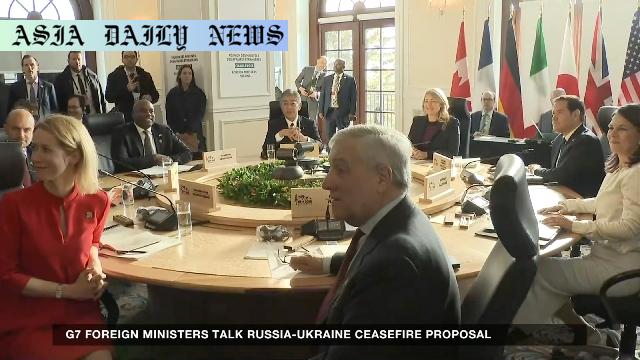Ceasefire: G7 foreign ministers discuss a US proposal aimed at resolving the ongoing conflict between Russia and Ukraine diplomatically.
Focused discussions on the US-proposed ceasefire between Russia and Ukraine.
G7 ministers aim for unity while balancing individual perspectives.
Efforts directed toward diplomatic conflict resolution.

Overview of the G7 Foreign Ministers’ Meeting
The G7 foreign ministers convened in Canada for a two-day meeting, with discussions significantly revolving around a crucial topic—a US-backed ceasefire proposal targeting the de-escalation of the ongoing conflict between Russia and Ukraine. Tensions between these two nations have continued for over a year, resulting in serious humanitarian and global security implications. The G7 ministers aimed to address this complex issue by promoting diplomacy while maintaining a united front on global matters of peace and stability.
This high-stakes dialogue underscores the urgency for action amidst growing geopolitical uncertainties. By highlighting the importance of collaborative conflict resolution, the G7 aims to elevate its influence in fostering stability in Eastern Europe. These discussions represent a delicate balancing act as ministers must navigate differing national perspectives while presenting a coherent and unified strategy to the world.
Key Discussions on Ceasefire Proposal
The US proposal for a ceasefire between Russia and Ukraine remains at the forefront of these discussions. It seeks to establish temporary peace to pave the way for broader diplomatic resolutions. This initiative has drawn mixed reactions among G7 members, given the diversity of geopolitical relationships that each nation maintains with Russia and Ukraine. Nonetheless, the ministers unanimously agree on the overarching goal of mitigating violence and preventing further loss of life in the region.
Diplomatic challenges persist as some member states express concerns over the enforceability of any ceasefire agreement, especially in light of previous breaches of similar arrangements. However, the G7 remains committed to exploring targeted measures to ease tensions and create an environment conducive to dialogue. Issues like economic sanctions, humanitarian aid, and potential pathways for negotiations have all surfaced as critical elements of the conversation.
Implications of a Unified G7 Strategy
A unified G7 strategy is expected to carry substantial international weight. By demonstrating cohesion, member nations can collectively reinforce the legitimacy of the ceasefire proposal while asserting their commitment to peacebuilding. Moreover, their actions could set a precedent for addressing other global conflicts through multilateral diplomacy and cooperation.
However, achieving consensus requires harmonizing differing priorities, strategic interests, and domestic political pressures. Each G7 nation must weigh the potential benefits of supporting the ceasefire plan against the risks of antagonizing key stakeholders or appearing ineffective in resolving the conflict. Ultimately, their success depends on their ability to present solutions that resonate with all parties involved in the ongoing crisis.
The Role of Public Perception and International Support
As the discussions conclude, G7 ministers will likely focus on shaping public perceptions and mobilizing international support for the ceasefire proposal. Public opinion can significantly impact the success of diplomatic efforts, especially in democracies where leaders must justify their foreign policy decisions to citizens.
Effective communication will be necessary to demonstrate how these initiatives serve global interests. Additionally, the G7 must work to engage other influential countries and organizations outside the group, seeking their endorsement and collaboration. Broadening the scope of support will ensure sustained momentum for the ceasefire initiative and further demonstrate the G7’s commitment to global peace.



Commentary
Balancing Unity and National Interests
The recent G7 meeting highlights the importance of collective diplomacy in addressing complex global challenges. The discussion surrounding a potential ceasefire between Russia and Ukraine underscores the role of multilateralism in fostering peace and stability. However, this comes with its own set of challenges, as member nations must reconcile their own interests while striving for unified action.
Striking this balance is no easy task, particularly when dealing with a conflict that has deeply entrenched roots and international ramifications. While the G7’s efforts are commendable, the intricacies of the Russia-Ukraine crisis demand coordinated strategies that go beyond temporary solutions. The emphasis on diplomacy and long-term stability is an encouraging sign of progress, but concrete actions will ultimately determine the success of these initiatives.
The Need for Collaborative Global Leadership
The G7’s efforts to mediate the Russia-Ukraine conflict also point to a growing need for collaborative global leadership. In an increasingly interconnected world, the ripple effects of conflicts can no longer be contained within regional boundaries; rather, they demand the attention and intervention of the international community.
The importance of engaging with other stakeholders, including non-G7 nations and international organizations, cannot be overstated. Broadening the table for dialogue ensures that all voices are heard and that the solutions adopted are not only comprehensive but also inclusive. Such an approach will build trust and credibility in global conflict resolution efforts.
The Road Ahead for Peace
While discussions on a ceasefire are a step in the right direction, the road ahead is paved with obstacles. Implementing a ceasefire requires meticulous planning, monitoring, and cooperation from all involved parties. It is essential to couple these efforts with a well-structured roadmap that addresses underlying issues, such as territorial disputes, governance, and humanitarian concerns.
As the G7 wraps up its talks, it is imperative that they capitalize on the momentum generated during these sessions. By committing to actionable steps and ensuring transparency in their approach, the G7 can set a strong example for future conflict resolution efforts. The world will be watching closely, hoping for tangible outcomes that pave the way forward toward peace and stability.